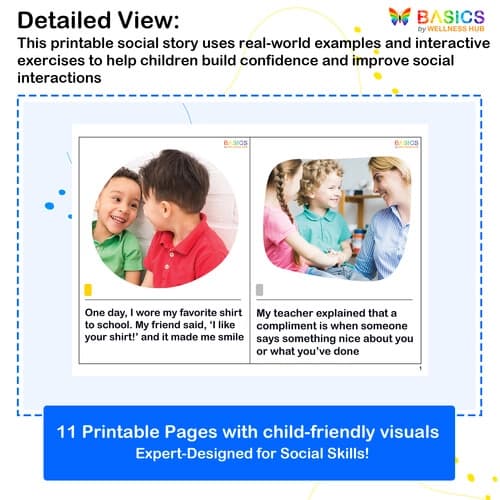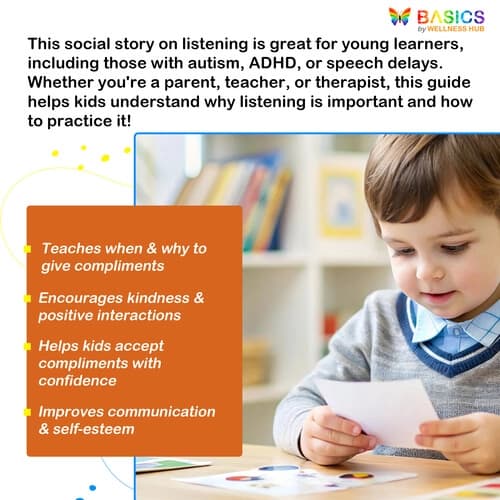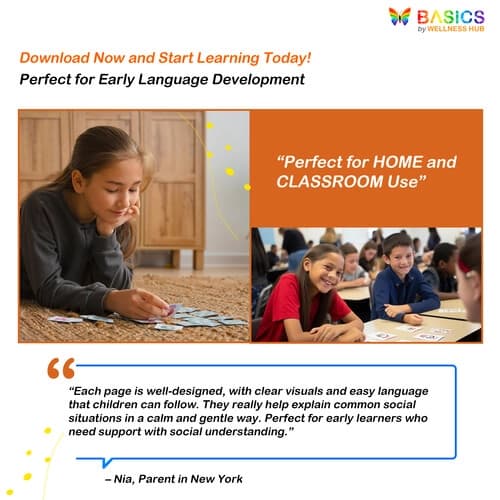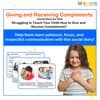

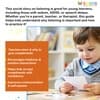
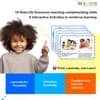
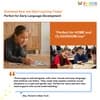
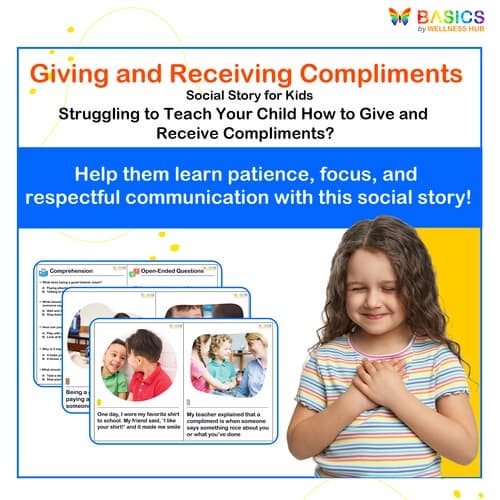
Giving and Receiving Compliments – Social Story for Kids
₹80
₹160
50% off
0 (0 ratings)
Grade Levels
Pre-K - Grade 3 (Ages 4-9)
Content Overview
Format: Printable PDF, Total Pages: 11, Features (≤15 words): 16 real-life scenarios, engaging illustrations, interactive activities, kid-friendly language
Categories
Pages from the Resource
Teach kids the importance of giving and receiving compliments with this engaging social story. Using real-life scenarios, interactive activities, and child-friendly illustrations, this resource helps kids build confidence, improve social interactions, and understand kindness. Ideal for home, classroom, and therapy use, especially for children with autism, ADHD, or social communication difficulties.
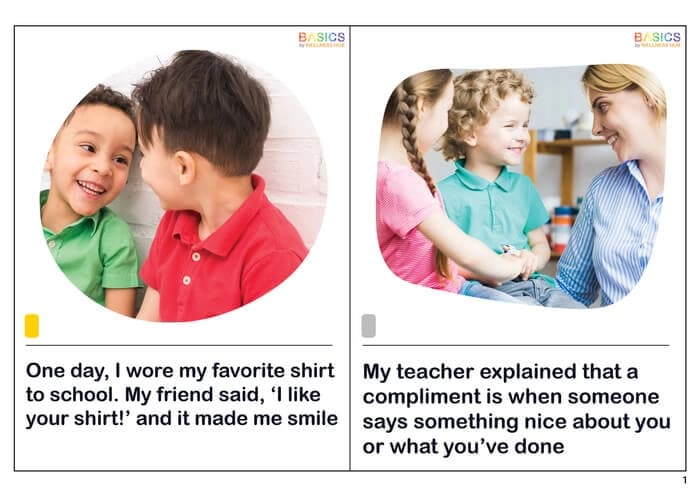
Page 1
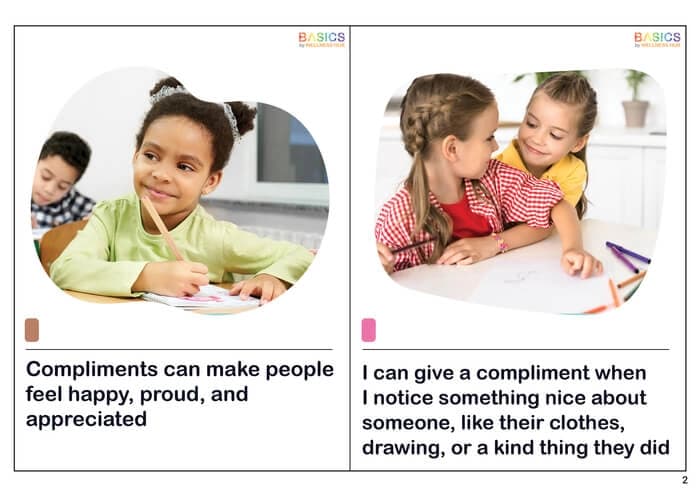
Page 2
What Users Say
0
0 ratings
5
0+
4
0+
3
0+
2
0+
1
0+
5 Stars
Product is Good to use.
1 year ago
Varsha Parent
Similar Products
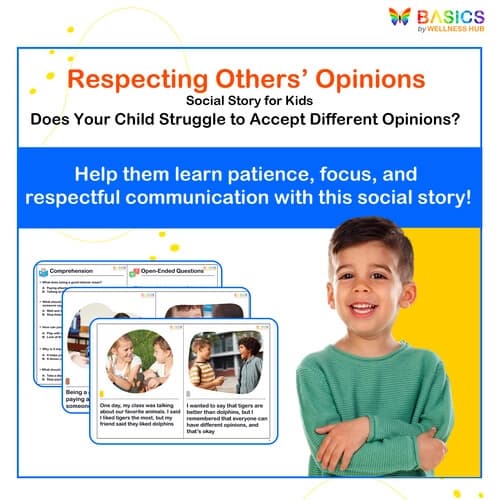
Respecting Others’ Opinions – Free Social Story for Kids
₹ 80.00
₹ 160.00
50% off
4.8 (46 ratings)
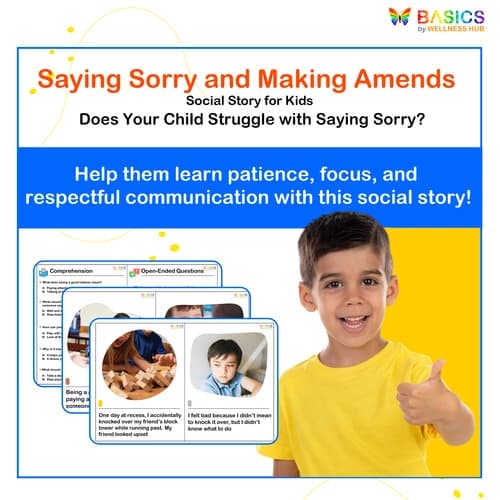
Saying Sorry and Making Amends – Social Story for Kids
₹ 80.00
₹ 160.00
50% off
5.0 (42 ratings)
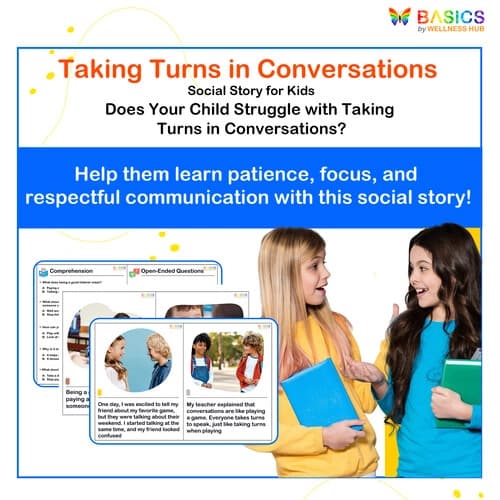
Taking Turns in Conversations – Social Story for Kids
₹ 80.00
₹ 160.00
50% off
4.9 (60 ratings)
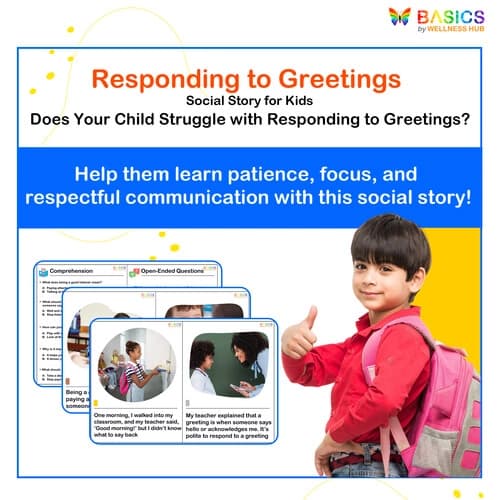
Responding to Greetings – Social Story for Kids
₹ 80.00
₹ 160.00
50% off
4.8 (56 ratings)

Understanding and Using Polite Words – Social Story for Kids
₹ 80.00
₹ 160.00
50% off
4.9 (48 ratings)
About the Product
Introduction
Giving and receiving compliments is a key part of positive communication and social interaction. Compliments help build self-esteem, kindness, and emotional intelligence, making children feel valued and appreciated. However, some kids may struggle with knowing how to give a compliment appropriately or how to accept one without feeling uncomfortable.
Children with autism, ADHD, or social communication challenges often have difficulty understanding the social rules around compliments, such as:
✔ When and how to give a compliment
✔ What words to use
✔ How to respond when someone compliments them
This social story teaches children how to give genuine compliments and graciously accept them, reinforcing the importance of kindness, confidence, and positive social interactions.
Through 16 real-life scenarios, engaging illustrations, and interactive activities, this resource helps children:
✔ Learn why compliments are important
✔ Understand the difference between genuine and insincere compliments
✔ Practice giving and receiving compliments in a natural way
✔ Build confidence and social-emotional skills
By consistently using this resource, children will develop positive communication habits, leading to stronger friendships, better self-esteem, and improved social interactions.
Product Details
- Format: Printable PDF
- Total Pages: 11
- Number of Segments: 16 real-life scenarios
- Features:
✔ Child-friendly illustrations to visually demonstrate giving and receiving compliments
✔ Simple language making it easy for kids to understand
✔ Interactive activities to practice complimenting others
✔ Designed for home, school, and therapy use
This easy-to-use social story can be printed or used digitally on tablets and computers.
Educational Benefits
1. Builds Social Confidence
- Helps children feel comfortable expressing positive thoughts to others.
- Encourages positive self-talk and self-esteem through learning how to receive compliments.
2. Enhances Social-Emotional Learning (SEL) Skills
- Teaches children how words can uplift and encourage others.
- Develops empathy by showing how compliments make others feel.
3. Supports Children with Special Needs
- Helps children with autism, ADHD, or social communication difficulties understand how and when to give compliments.
- Reinforces expected social behaviors through structured storytelling.
4. Encourages Positive Peer Interactions
- Strengthens friendships and classroom relationships.
- Promotes respect, kindness, and inclusion in social settings.
5. Provides Real-Life Application
- Uses everyday scenarios (e.g., complimenting a friend’s artwork, responding to praise from a teacher).
- Encourages kids to practice compliments in natural settings (home, school, playground).
Instructions for Use
Step 1: Read the Social Story Together
- Sit with the child and read the story aloud, emphasizing key phrases.
- Discuss each scenario and illustration, ensuring the child understands what makes a good compliment.
- Ask guiding questions like:
- “Why do you think giving compliments is important?”
- “How do you feel when someone compliments you?”
Step 2: Engage in Interactive Learning
- Encourage role-playing by practicing giving compliments in a safe, low-pressure setting.
- Use the interactive activities included in the resource, such as:
✔ Completing sentence prompts (e.g., “I like your _____ because _____.”)
✔ Sorting good vs. bad compliments (e.g., “Nice shirt!” vs. “That shirt isn’t awful.”)
Step 3: Encourage Real-Life Application
- Challenge the child to give at least one genuine compliment per day.
- Create a compliment journal where they can write down compliments they’ve given and received.
- Provide gentle reminders when they receive compliments (e.g., “Say thank you when someone gives you a compliment.”).
Step 4: Revisit & Reinforce
- Read the social story regularly to reinforce learning.
- Model complimenting others frequently so the child learns by example.
- Praise and encourage the child when they give and receive compliments appropriately.
Activities Using the Resource
These interactive activities are designed to reinforce the importance of compliments and help children practice giving and receiving them in a fun, engaging way.
1. Compliment Circle (Group Activity)
Objective: Help children feel comfortable giving and receiving compliments in a supportive environment.
Materials: None.
How to Play:
- Gather children in a small group or classroom setting.
- One child gives a compliment to the person on their right (e.g., “I like how you share your toys”).
- That child responds by saying ‘Thank you!’ and then gives a compliment to the next person.
- Continue until everyone has given and received a compliment.
- Discussion: Ask the children how they felt when they gave and received compliments.
2. Compliment Jar (Daily Practice Activity)
Objective: Encourage children to notice and appreciate positive qualities in others.
Materials: A jar, paper slips, and markers.
How to Play:
- Set up a compliment jar in the classroom or at home.
- Throughout the day, encourage children to write down compliments they notice about others.
- Read the compliments aloud at the end of the day or week.
- Discussion: Talk about how it feels to hear nice things about oneself and others.
3. Role-Playing Compliment Scenarios
Objective: Teach children how to give and accept compliments in different social situations.
Materials: Flashcards with scenario prompts.
How to Play:
- Read a scenario card aloud (e.g., “Your friend drew a great picture. How would you compliment them?”).
- Ask the child to come up with a compliment that fits the situation.
- If needed, provide sentence starters like:
- “I like your _____ because _____.”
- “You did a great job at _____.”
- The other child responds with a polite acceptance (e.g., “Thank you! That means a lot!”).
- Switch roles so that all children practice both giving and receiving
4. Compliment Sorting Game (Good vs. Bad Compliments)
Objective: Help children recognize genuine and appropriate compliments.
Materials: Pre-written compliment cards.
How to Play:
- Print or write out compliments and backhanded/insincere compliments (e.g., “Nice hair today!” vs. “At least you tried.”).
- Have the child sort them into two categories: Good Compliments Not So Good Compliments.
- Discussion: Talk about why certain compliments feel good and why others might not.
FAQs
Q1: Who is this social story designed for?
A1: This resource is created for children aged 4–9 who are learning how to communicate positively and build social confidence. It’s particularly helpful for children with autism, ADHD, speech delays, or social communication challenges who may struggle with when and how to give or receive compliments.
Q2: How often should I use this social story?
A2: Use it regularly (at least once a week) to help children internalize the lessons.
Complement it with interactive activities to reinforce polite and kind communication.
Encourage daily real-life practice by reminding kids to give and accept compliments in natural settings.
Q3: My child feels awkward receiving compliments. What should I do?
A3: ✔ Reassure them that compliments are a way to show kindness.
✔ Practice different ways to respond, such as:
- Smiling and saying, “Thank you!”
- Returning a compliment, e.g., “I like your shoes too!”
✔ Use role-play to help them get used to hearing and accepting positive words.
Q4: How can I encourage my child to give compliments naturally?
A4: ✔ Model good behavior by giving compliments to family members and friends.
✔ Use a compliment challenge where the child gives at least one compliment per day.
✔ Make it fun by using games like the Compliment Jar or Compliment Circle.
Q5: Can I use this social story in a classroom or therapy setting?
A5: Absolutely! This social story is designed for use in:
✔ Classrooms – To promote positive peer interactions and classroom culture.
✔ Therapy sessions – To help children with autism, ADHD, and speech delays improve their social communication skills.
✔ At home – Parents can use it to reinforce kindness and emotional intelligence in daily life.
Usage Rights and Restrictions
Allowed Usage:
- Personal use for parents, teachers, and therapists.
- Printable for classroom, home, or therapy sessions.
- Can be used in group or one-on-one settings.
Not Allowed:
- Reselling, redistributing, or modifying the resource for commercial use.
- Sharing publicly (e.g., on blogs or social media) without permission.
- Uploading to websites for free distribution.
If you need a bulk license for schools or therapy centers, please contact us!
Conclusion
Learning to give and receive compliments is an essential skill that helps children build positive relationships, confidence, and empathy. The “Giving and Receiving Compliments” social story provides clear, structured guidance through real-life examples, engaging illustrations, and fun interactive activities to reinforce learning.
By reading, practicing, and encouraging polite communication, children will:
✔ Feel more comfortable expressing kindness.
✔ Learn to accept compliments with confidence.
✔ Develop stronger friendships and better social skills.
With patience and practice, compliments will become a natural part of a child's communication!
